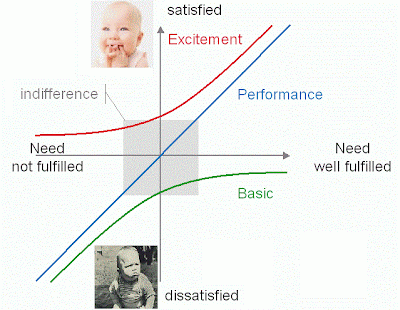The Kano model is a theory of product development and customer satisfaction developed in the 80s by Professor Noriaki Kano.
The Kano Model offer a tool commonly used in the product development process to help classify customer wants and needs into one of three main categories.
The first category is called Basic Needs. Basic Needs are customer needs that are usually unspoken unless they are violated. These types of needs don’t add to the overall customer satisfaction of the product, but they can take away from the satisfaction level if they are not met. An example of a Basic Need in an automobile is its ability to keep water from entering the inside of the car and getting the driver wet. A car owner never runs over to his neighbor and brags about how well his new car keeps water out; this is because it is expected. However, if his new car leaked water on him when he went through the car wash, you bet he would complain to his neighbor about that!
The second category is called Performance Needs. Performance Needs are things that the customer will most likely talk about in everyday conversation. These types of needs add to the customers overall satisfaction when delivered well and detract from their overall
satisfaction when done poorly. An example of a Performance Need in the hotel industry would be the quality of the view from your hotel room. If the view is terrible, say looking straight at a brick wall two feet away, the customer would most likely complain about it and be upset. However, if the view is overlooking a beautiful bluff with a view of the ocean, then the customer will be very satisfied.
The third category is called Excitement Needs. Excitement Needs are customer needs that are usually unspoken because the customer doesn’t even know that they are possible. These needs don’t detract from the overall customer satisfaction level because the customer doesn’t even know it is possible but, if they discover it in their product they are excited and feel like they got something extra.
mardi 23 août 2011
lundi 1 août 2011
Systematic Innovation
Description: A content rich and dynamic video on Systematic Innovation that includes several Innovation best practices used by industry leaders for structured innovation.
mercredi 20 juillet 2011
A soccer ball generates electricity while being kicked around
Yes now Africans parents will tell their children it's time to go play football :-)
A team of four engineering students at the Harvard University have come up with an ingenious idea that could change the lives of rural African people. The students have designed a unique soccer ball that generates electricity when being kicked around.
Dubbed the SOccket, the ball captures the energy from impact that is usually lost to the environment. The generated electricity is then stored in the ball, which after dark can be used to light an LED lamp or charge a cell phone.
A team of four engineering students at the Harvard University have come up with an ingenious idea that could change the lives of rural African people. The students have designed a unique soccer ball that generates electricity when being kicked around.
Dubbed the SOccket, the ball captures the energy from impact that is usually lost to the environment. The generated electricity is then stored in the ball, which after dark can be used to light an LED lamp or charge a cell phone.
samedi 16 juillet 2011
Wall of obstacles to success
As an entrepreneur you will probably face a lot of obstacles, I think the wall below is a good representation of those obstacles, if you want to break this wall you have to be patient and believe in your idea.
mercredi 13 juillet 2011
Matt Cutts: Try something new for 30 days
Matt Cutts is an engineer at Google, where he fights linkspam and helps webmasters understand how search works.
Description: Is there something you've always meant to do, wanted to do, but just ... haven't? Matt Cutts suggests: Try it for 30 days. This short, lighthearted talk offers a neat way to think about setting and achieving goals.
Description: Is there something you've always meant to do, wanted to do, but just ... haven't? Matt Cutts suggests: Try it for 30 days. This short, lighthearted talk offers a neat way to think about setting and achieving goals.
Inscription à :
Commentaires (Atom)
From quotes of wisdom


